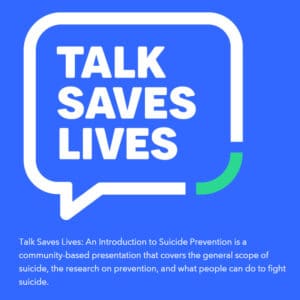
We all have a role in Suicide Prevention. Suicide is the second leading cause of death among young people 10 to 24 years of age, following unintentional injuries. There are many practical, effective interventions parents and others can undertake to decrease the risk of a child attempting or dying by suicide.
We can all help prevent suicide. Every year, mental health organizations and individuals across the U.S. and around the world raise awareness of suicide prevention during September, National Suicide Prevention Month. This is a time to remember the lives lost to suicide, the millions of people who have and continue to struggle with mental health and suicide ideation, and to acknowledge all those who have been impacted by suicide.
Join the HIPRC in honoring World Suicide Prevention Day and National Suicide Prevention Week, time dedicated during the month of September to remember those affected by suicide, to raise awareness, and to focus efforts on directing treatment to those who need it most. Share resources, stories, and promote suicide prevention awareness within your community.
Source: American Foundation for Suicide Prevention (AFSP); Substance Abuse and Mental Health Services Administration (SAMHSA)
Source: SAMHSA, 988 Suicide & Crisis Hotline, Trust for America’s Health’s (TFAH), Crisis Text Line, Suicide Prevention Resource Center (SPRC), and Centers for Disease Control & Prevention (CDC)
Source: AFSP
Source: AFSP; UW Forefront
Source: AFSP
The American Foundation for Suicide Prevention (AFSP), a leading suicide research and prevention organization in the U.S., invites those who have lost someone to suicide to participate in a day of healing.
International Survivors of Suicide Loss Day (also known as “Survivor Day”) is a day for those affected by suicide loss to gather (in-person and virtually) at one of more than 300 events held worldwide on or near the day’s observance to find connection, understanding, and hope through shared experiences.
AFSP provides a safe space where survivors of suicide loss are encouraged to come together in their local communities to find comfort and community as they share stories of healing and hope. Survivor Day events offer attendees the opportunity to learn coping strategies, embrace grief and discover resources to help with each unique healing journey.
All Survivor Day events are closed to the media to protect the confidentiality and grieving process of survivors. These events encourage attendees to share their stories openly and honestly in order to drive grief support and healing. Most Survivor Day events are for ages 18+ and older to attend.
To learn more, visit >> survivorday.org.
To connect with suicide loss survivors in your area, visit >> isosld.afsp.org.
Share AFSP’s Living with Suicide Loss video series >> featuring personal stories, journeys, and wisdom of those who have affected by suicide loss.
Source: PRNewswire and the American Foundation for Suicide Prevention (AFSP)
In 1999, Survivor Day was created by an Act of Congress following the passage of a resolution introduced by Senator Harry Reid, whose father took his own life in 1972. Each year, the American Foundation for Suicide Prevention (AFSP) sponsors the Survivor Day program that unites survivors of suicide loss across the world.
AFSP is dedicated to saving lives and bringing hope to those affected by suicide, including those who have experienced a loss. AFSP creates a culture that’s smart about mental health through public education and community programs, develops suicide prevention through research and advocacy, and provides support for those affected by suicide. Led by CEO Robert Gebbia and headquartered in New York, and with a public policy office in Washington, D.C., AFSP has local chapters in all 50 states, DC and Puerto Rico with programs and events nationwide.
For more information, visit: afsp.org.

Talking is the first step to preventing suicide.
YOU can make a difference by learning the warning signs and risk factors, having a REAL conversation with someone you care about, and sharing resources and creative ways to help #TalkAwayTheDark.
Learn more & share these resources:
If you or someone you know is in a crisis:
Suicidal thoughts, much like mental health conditions, can affect anyone regardless of age, gender or background. In fact, suicide is often the result of an untreated mental health condition. Suicidal thoughts, although common, should not be considered normal and often indicate more serious issues. Everyone in Washington has a role in suicide prevention, suicide is a preventable public health problem.
Defining Terms:
Visit the Suicide Prevention Resource Center for more information and educational resources including Suicide Prevention Courses.
Recognize the signs. Know what to do.
Among both children and adolescents, the warning signs of suicide can include:
Among teenagers, the warning signs of suicide can also include:
Suicidal ideation, self-injurious behaviors, and suicide attempts are most often associated with depression. In addition to depression, other risk factors include:
If someone talks about or exhibits behaviors that make you suspect the person is suicidal, follow these steps:
Courtesy: AACAP
Communities facing barriers include the following:
Multigenerational Families
Trauma and grief can be passed from one generation to the next, especially through cycles of family violence. This can increase risky behaviors. For adults in the family, there can be an impulse to hide a family member’s suicide and to keep it as a secret. Lying or hiding information from younger members of the family about painful memories can erode trust. As some behavioral health problems have genetic ties, it may be important for younger generations to understand if they are at risk.
How to talk about suicide
American Indians & Alaska Natives (AI/AN)
AI/AN Resources & Research
In addition to the suicide risk factors that face most young Americans, American Indian/Alaska Native youth have layers of risk that increase their susceptibility to suicidal thoughts. According to the Indian Health Service, they may feel cut off from other people, or isolated on reservations, perceive or suffer discrimination, or be burdened by historical trauma shared by earlier generations related to experiences of colonialism, wars, dislocation from land, and separation from family by Indian boarding schools.
Culturally Relevant Approaches to Preventing Suicide Among American Indian and Alaska Native Youth – Children’s Safety Network (CSN)
Seattle Indian Health Board – Mental Health Services
Indian Health Service – U.S. Department of Health and Human Services
Advancing suicide prevention research with rural American Indian and Alaska Native populations
Relative to the tremendous toll suicide takes on American Indian and Alaskan Native communities, there is a substantial deficit in research. If you have data or resources you would like us to add, please let us know (hiprccom@uw.edu).
Veterans
See the complete 2022 National Veteran Suicide Prevention Annual Report, here >> (U.S. Department of Veterans Affairs)
Veteran Resources & Research
Veterans and active duty soldiers face unique circumstances. According to the U.S. Department of Veterans Affairs, emotional and mental health crises are heightened for men and women who serve or have served in the military. Studies found this to be particularly true in the three years immediately following deployment. The VA says that these unique factors exacerbate crisis moments for veterans:
These resources will help you learn more about veterans and suicide. If you work for an organization that would like to have a resource added, please let us know.
LGBTQI+
In a national study, 40% of transgender adults reported having made a suicide attempt. 92 percent of these individuals reported having attempted suicide before the age of 25.4
LGBTQI+ Resources & Research
Like other oppressed communities, LGBTQI+ communities are disproportionately at risk for suicide and other mental health struggles due to historic and ongoing structural violence. This section has information and resources for those looking for help and support for yourself or loved ones who identify within the vast, diverse, and thriving LGBTQI+ communities.
Suicide rates have been increasing for two decades now. Moreover, youth suicide has risen in recent years, along with anxiety and depression. Suicide is the 2nd leading cause of death among young people 10 to 24 years of age, following unintentional injuries, in the United States.
Furthermore, the COVID-19 pandemic caused fear, anxiety, loneliness, and grief. Its social isolation may raise the risk of depression for years into the future. One in three middle and high school students surveyed in 2022 were pretty or extremely worried about friends or family getting sick with COVID-19.
Courtesy: CDC; AFSP; Washington State Department of Health
Make the commitment to check-in with your family, friends, colleagues, or loved ones. Making it a point to check in on kids’ daily mental health gives them a window of opportunity to ask for help if or when they need it.
To start a conversation:
If you have lost someone to suicide, the first thing you should know is that you are not alone. Each year, nearly 48,000 people in the United States die by suicide — the grieving family and friends they leave behind are known as suicide loss survivors. In fact, research shows that during the course of our lives, many of us will lose someone we care about to suicide. That means there are millions of suicide loss survivors who, like you, are trying to cope with this heartbreaking loss.
Suicide loss survivors often experience a wide range of grief reactions.
Learn more and provide support:
Attend an event >> intheforefront.org
Watch this video >> Suicide Prevention & Understanding Grief
Share these resources >> Suicide Prevention & Understanding Grief after Suicide, Traditional & Non-Traditional Therapies, and Suicide Grief Resources
Sources: American Foundation for Suicide Prevention (AFSP) and UW Forefront Suicide Prevention
If you are considering suicide or self-harm:
Additional Resources:
For families with private insurance:
For families with Medicaid:
Visit our Digital Resource Center to learn more about Suicide Prevention — plus, more injury and violence prevention topics year-round!
CALL or TEXT 9-8-8, or CHAT online with the National Suicide Prevention Lifeline>>
This website is provided for educational and informational purposes only and does not constitute providing medical advice or professional services. The information provided should not be used for diagnosing or treating a health problem or disease, and those seeking personal medical advice should consult with a licensed physician. No physician-patient relationship is created by this website or its use. Neither HIPRC, the University of Washington, nor its employees, nor any contributor to this website, makes any representations, express or implied, with respect to the information provided herein or to its use.